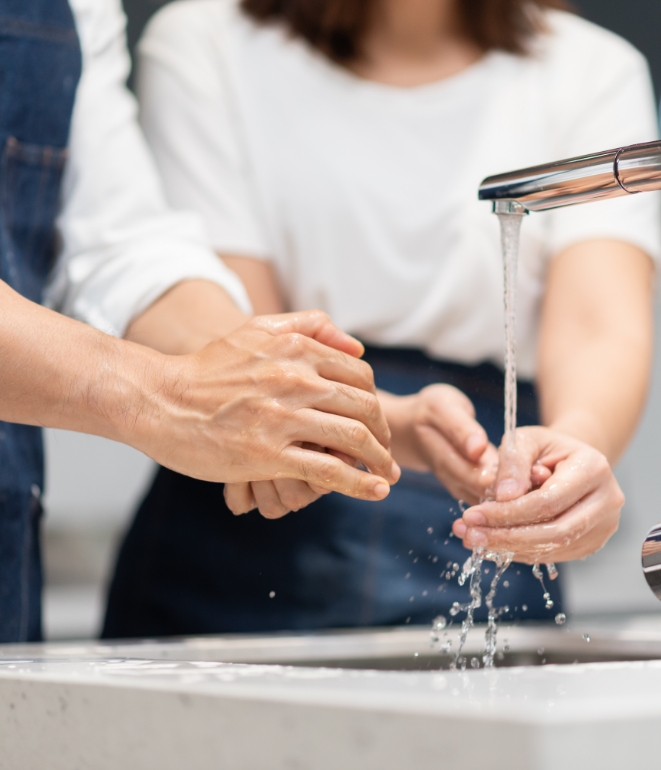Garrett, IN Water Heater Installation

Get the Reliable Hot Water Your Home Needs
Few things are as frustrating as stepping into a cold shower or running out of hot water halfway through washing the dishes. Whether your current water heater can’t keep up or it’s finally given out on you, we know you just want one thing—a reliable system that keeps your home comfortable and your family happy. And you need a reliable local plumber to guide you through every step of the process, from selecting a new water heater to installing it with precision.
T&T Plumbing & Heating, Inc. offers water heater installation in Garrett, IN, and the surrounding DeKalb County area. that provides you with reliable access to hot water whenever you need it. We’ll guide you through every step—so you can stop worrying about water temperature and start enjoying the comfort you deserve.
Don't Let Cost Delay Your Comfort
T&T Plumbing & Heating, Inc. offers convenient financing plans to make water heater installation costs in Garrett, IN, affordable for every homeowner. Apply today and enjoy hot water now, pay over time!
Why Garrett Homeowners Choose T&T Plumbing & Heating, Inc. for Water Heater Installation
When it comes to something as essential as your home’s hot water supply, you want a team you can trust. Garrett homeowners consistently turn to T&T Plumbing & Heating, Inc. for water heater installation because we deliver top-tier equipment and unmatched service.
With decades of experience serving Northeast Indiana, our licensed professionals are known for precise workmanship, honest recommendations, and on-time, clean installations. We take the time to understand your household’s needs and guide you to the right solution. From start to finish, we make the process easy on you.
Is Your Water Heater Due for a Replacement?
Not sure if it’s time to replace your old water heater? Here are some signs that indicate you may need a new unit:
Age of the Unit: Most conventional water heaters last about 10-15 years. If your system is approaching or exceeding this age, consider a replacement.
Inconsistent Hot Water Supply: If you notice fluctuating water temperatures or an inconsistent hot water supply, it may signal that your water heater is failing.
Unusual Noises: Strange noises, such as banging or popping, can indicate sediment buildup inside the tank. If this is happening frequently, it might be time to replace your unit.
Leaks or Corrosion: Visible leaks or signs of rust and corrosion are clear indicators that your water heater needs attention.
If you’re experiencing any of these warning signs, take action before your hot water system fails completely. T&T Plumbing & Heating, Inc. can inspect your water heater to assess its condition and determine whether water heater repair or a full replacement is necessary. Our skilled technicians will evaluate factors like age, performance, and signs of damage to provide you with an honest recommendation.
By choosing our expert services, you can ensure that your home has a reliable hot water supply, keeping you comfortable and stress-free. Don’t wait for a complete breakdown—contact us today for a professional assessment and let us help you make the best decision for your home and budget!
How to Select a New Water Heater
When planning for your new water heater installation, several important factors can influence your decision. Understanding these elements will help ensure that you choose a unit that meets your family’s hot water needs while also being efficient and reliable. Here are the key considerations to keep in mind:
Type of Water Heater
Each type of tank water heater operates differently, affecting everything from your monthly utility bills to your home’s hot water recovery time.
Gas Water Heaters
Gas-powered models are a popular choice for households that want fast, efficient water heating. They use natural gas or propane to quickly heat large volumes of water, making them ideal for families with higher hot water demands.
Electric Water Heaters
Electric water heaters are reliable, affordable, and easy to maintain. These models often have lower upfront costs and can be installed almost anywhere, from a utility closet to a basement
Heat Pump Water Heaters
Also known as hybrid water heaters, these systems use electricity to move heat from the surrounding air into the water, rather than generating it directly. Heat pump mode makes them one of the most energy-efficient options on the market.
Size and Capacity
The size of your tank water heater is one of the most critical factors to consider. Tank water heaters come in various capacities, typically ranging from 20 to 80 gallons. To determine the appropriate size, consider your household’s hot water consumption.
- First-Hour Rating (FHR): This rating indicates how much hot water the unit can deliver in the first hour of use, accounting for water already in the tank. A larger FHR is necessary for families with higher hot water needs, especially during peak usage times like morning showers or dishwashing.
- Daily Hot Water Needs: Estimate your daily hot water needs based on the number of people in your household and common activities, such as showering, laundry, and dishwashing. This will help you select a tank size that can accommodate your household’s usage patterns.
Energy Efficiency
Energy efficiency is vital when choosing a tank water heater, as it directly affects your utility bills. Look for gas, electric, and heat pump water heater models with a high energy factor (EF) rating, which measures the unit’s efficiency in converting energy to hot water. Higher EF ratings indicate better efficiency.
Consider selecting a water heater that has an Energy Star label. These models meet strict energy efficiency guidelines, helping you save on energy costs while reducing your environmental impact.
Fuel Source
Tank water heaters can operate on various fuel sources, including electricity, natural gas, or propane. When choosing a fuel source, consider the following:
Availability and Cost: Assess the availability of the fuel source in your area and its associated costs. Gas water heaters typically heat water faster and may have lower operating costs compared to electric water heater models. However, they may require additional installation considerations, such as venting.
Existing Infrastructure: If your home already has gas lines, a gas water heater may be a more convenient choice. If your home is totally electric, an electric tank water heater might be easier to install, and you won’t have to spend extra money installing new gas lines.
Initial and Operating Costs
Evaluate both the initial purchase price and the long-term operating costs of the water heater. Tank water heaters typically have lower upfront costs than tankless water heaters, making them an attractive option for many homeowners. Financing is available to help you purchase the new water heater you need without a major upfront hit to your savings.
Consider the long-term operational costs, including energy bills. While a less expensive model may save you money upfront, it might lead to higher energy costs down the line if it’s not energy-efficient.
Warranty and Maintenance
The warranty offered by the manufacturer can be a good indicator of the unit’s durability. Most tank water heaters come with warranties ranging from six to twelve years following your water heater installation. A longer warranty generally reflects a higher-quality unit.
Tank water heaters require regular maintenance to operate efficiently, such as flushing the tank to remove sediment buildup and checking the anode rod to prevent corrosion. T&T Plumbing & Heating, Inc. offers water heater maintenance in Garrett, IN, to make sure these important tasks are completed.
How a New Water Heater Is Installed
Installing a new water heater is a multi-step process that requires precision, expertise, and attention to safety. At T&T Plumbing & Heating, Inc., we follow all manufacturer’s instructions, as well as a detailed procedure to ensure your new water heater performs efficiently and safely for years to come. Here’s a breakdown of what happens during a professional installation:
1. Initial Assessment and Removal of the Old Unit
Before anything is installed, our technicians perform a full inspection of your current system and plumbing layout. This includes:
Shutting off power or gas supply to ensure safety
Draining the old tank using a hose to empty it completely
Disconnecting supply lines, including the cold water supply inlet and hot water supply line
Removing the exhaust vent (for gas units) or electrical connections (for electric units)
Hauling away the existing water heater for proper disposal or recycling
2. Preparing the Installation Area
Next, we prepare the space to accommodate your new water heater:
Inspecting the water lines and shutoff valves for any wear or corrosion
Ensuring proper ventilation and clearance if it’s a gas model
Installing a new drain pan (especially in basements or attics)
Placing a thermal expansion tank if required by local codes
3. Positioning and Securing the New Unit
Once the space is ready, we bring in your new water heater:
Carefully positioning it to allow proper airflow and code-compliant clearance
Leveling the tank to prevent stress on water lines and ensure proper drainage
Anchoring the unit for safety
4. Connecting the Plumbing
We now attach all the necessary water lines:
Cold water inlet and hot water outlet pipes are connected using dielectric unions to prevent corrosion
New flexible connectors or copper piping are installed as needed
Pressure relief valve (TPR valve) is added with a discharge line, and routed to a floor drain if available
Thermal expansion tank is connected, if applicable, to relieve pressure from heating cycles
5. Connecting Gas or Electricity
Depending on your water heater type:
The gas supply line is connected using a shutoff valve and tested for leaks
The flue vent is attached and aligned to allow proper exhaust flow
Electrical wiring is connected to the main service panel
A dedicated circuit breaker is checked or installed if required
6. Filling and Testing the System
After all connections are made:
The tank is filled with water while air is purged from the system
All joints and connections are tested for leaks
The power or gas supply is turned back on, and the unit is started
Thermostatic mixing valve is tested for proper water temperature delivery
Water flow and pressure are tested at each hot water faucet to confirm smooth operation
7. Final Inspection and Cleanup
Once the unit is running:
Our technicians perform a safety inspection to confirm all systems are working as they should
We walk you through the new system, showing you how to operate and maintain it
All debris and old materials are removed, leaving your home clean and tidy
Water Heater Installation Done Right
A water heater is a critical component of your home’s comfort, and at T&T Plumbing & Heating, Inc., we make sure the installation is done right the first time. Whether you’re upgrading for efficiency or replacing a failing unit, we make sure every part—down to the pressure reducing valve, pipes, and settings—is perfectly in place.
Frequently Asked Questions About Water Heater Installation
Can I install a water heater myself?
Installing a water heater yourself might seem like a way to save money, but it’s not recommended. Proper installation requires plumbing, electrical, and sometimes gas line expertise. Mistakes can lead to leaks, inefficiency, or safety hazards. It’s always safer and more reliable to have licensed professionals like T&T Plumbing & Heating, Inc. handle the job.
Will a plumber install a water heater I bought?
Many plumbers prefer to supply the unit they install to ensure compatibility, warranty coverage, and quality control. It’s best to call ahead to discuss your specific situation.
How long does it take to install a 40-gallon hot water heater?
A standard 40-gallon tank water heater installation typically takes about two to three hours. This includes removing the old unit, connecting the new one, testing for leaks, and ensuring everything operates safely and efficiently. Complex setups or code updates may add extra time.
What is the life expectancy of a water heater?
Most traditional tank water heaters last around 8 to 12 years, depending on maintenance, water quality, and usage. Regular care like flushing the tank and replacing the anode rod can help extend its lifespan. When your unit nears the 10-year mark, it’s wise to start planning for a replacement.
How often should I flush my water heater?
Flushing your water heater once a year is typically enough to prevent sediment buildup, which can reduce efficiency and shorten its lifespan. Homes with hard water, like many in DeKalb County, may benefit from flushing more often. T&T Plumbing & Heating, Inc. can perform this service to help keep your system running smoothly.
Contact T&T Plumbing & Heating for Water Heater Installation in Garrett, IN
If you’re ready to upgrade your water heater or need a new installation, T&T Plumbing & Heating, Inc. is here to help. Our team of experts is dedicated to providing quality service and ensuring your home has the hot water you need. Contact us today to schedule a consultation for water heater installation in Garrett, IN.

